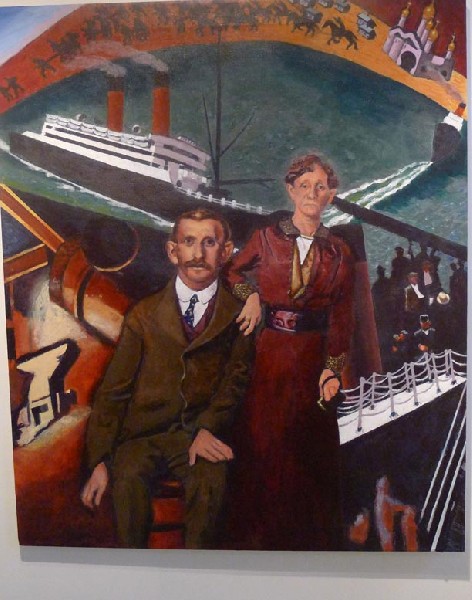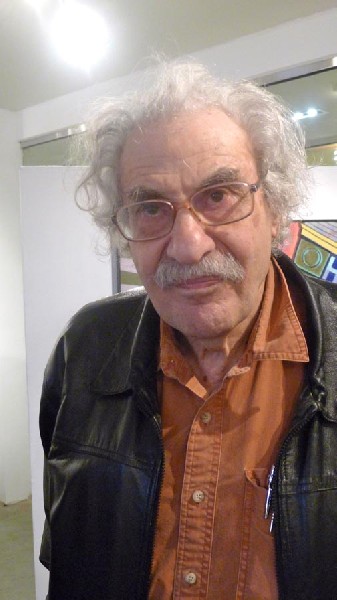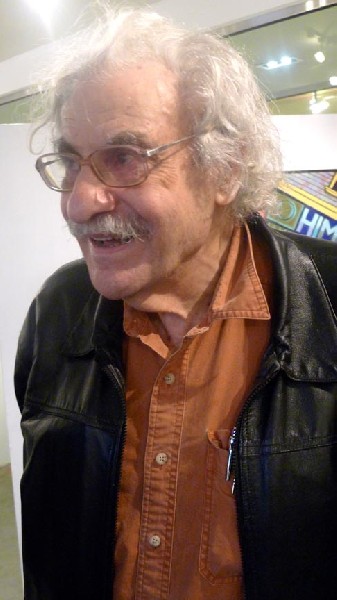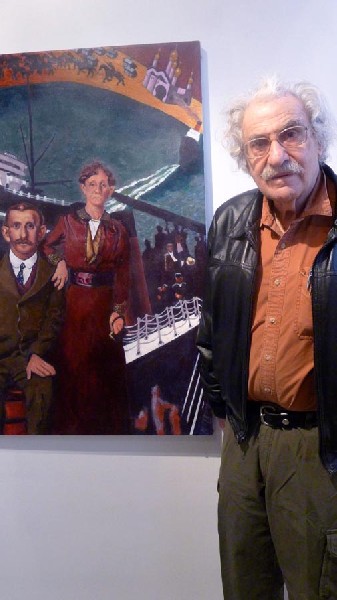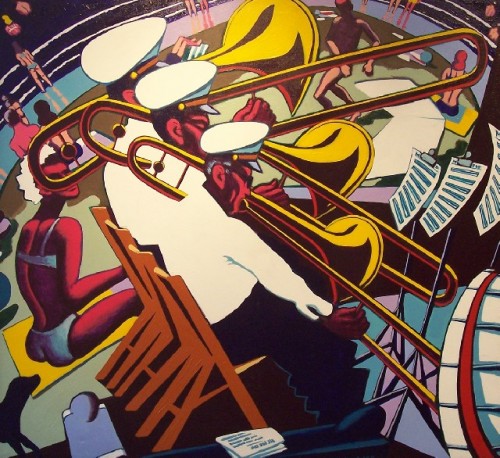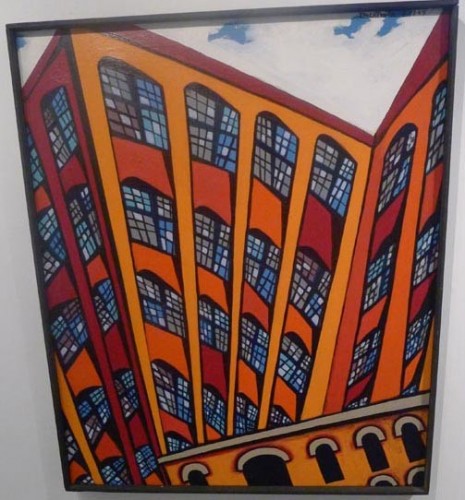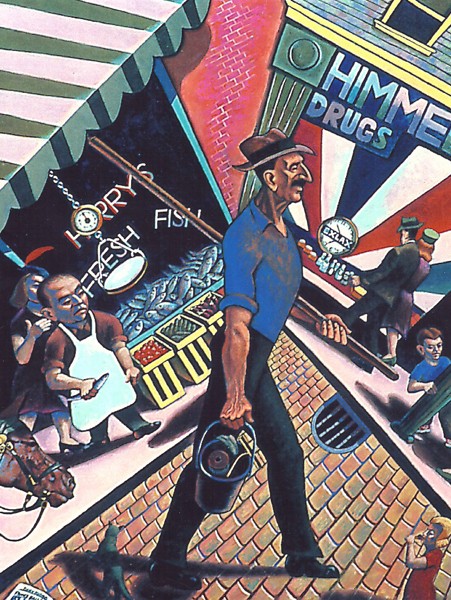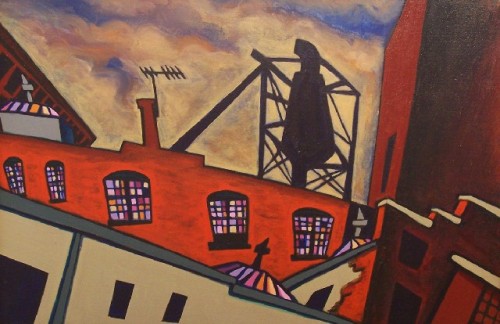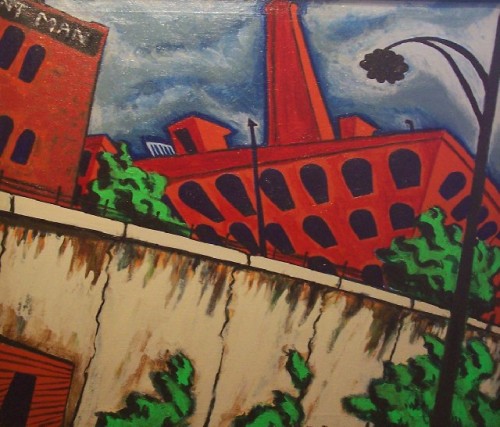Arnold Trachtman At Galatea Fine Art
Masterful Expressionist Memories of Lynn, Massachusetts
By: Mark Favermann - May 04, 2012
Arnold Trachtman is an artist of unique qualities. His visual statements, either in drawings, water colors or acrylics are full of strong image and content.
At 82, he is still very much a New England boy of an immigrant Jewish-American working class background from the downwardly spiraling small city of Lynn, Massachusetts. Either in still life, landscape or portraiture, his work documents his and our shared American history, experience and environment.
His politics are unalterably leftist; his thoughts are often cynical, yet his anger is measured and thoughtful. There is a smile and twinkle in his eye to moderate his passion. And yet, relentlessly he is compelled to create, to express, to document history through a personal lens. His vision and personal style are a holdover and quite individual translation of the Social Realists and Mexican muralists genres of the 1930s and '40s.
Art history of the last half of the 20th Century documents how social realists, got pushed aside and downgraded when the "high art" of Abstract Expressionism, Minimalism, conceptual art, performance art, etc represented Post WII American Art.
Trend-setter and most ambitious artists try to surf and catch the next creative wave and aftersplash of critical taste. Unlike these chic, "smarter" artists, Arnold Trachtman never read the memo. Or, if he did, he quickly threw it away. His working class stubbornness had him continue to swim against the tide.
As BFA Publisher/Executive Editor Charles Giuliano wrote, "Arnold Trachtman is the only member of his own sleeper cell of ersatz revolutionaries." For most of his career, he has been a committed Marxist whose art is devoted to the mandate of agitation and propaganda through expressionistic visual storytelling. Trachtman wants to share history.
After high school in Lynn, Trachtman attended Mass College of Art and Design. He later received his masters degree from the Chicago Art Institute.
This Galatea Fine Art Gallery exhibition is something of a departure from Arnie's usual fare. All of his paintings have a sense of memory, either historical, horrific, nostalgic or polemic, but these are much more highly personal. Unlike other previous exhibits, this strong show is a family album of Trachtman's memories of his childhood hometown and some of his most important relatives.
Though there are several strong pieces included, My Grandfather stands out. Here he depicts his lanky, strong, mustachioed (a family trait?) hardworking granddad walking to work in the vibrant but not affluent Lynn, Massachusetts.
The full length portrait is set geometrically against a streetscape of cobblestones, shops and people. By the way it is painted, it appears to have forward motion. The streetscape is expressionistically organized into a whirlygig or pinwheel of potential action and spin. Content supercedes composition in all of Trachtman's paintings.
This painting takes the mundane and makes it somehow marvelous. The artist has portrayed working class pride (the grandfather) as well as a pride of place (in the small mill city of Lynn) expressed in color and form. There is an evocative skewer of perspective that heightens the elements of the picture. Somewhat like the visual poetry of a Chagall painting, we see the grandfather walking on the street or maybe on a roof while architectural details, symbolic elements, shopkeepers and signs appear to float and interact.
Another poignant portrait is My Maternal Grandparents: Crucible. Here Arnie's Eastern European immigrant grandfolks are formally arranged like an early 20th Century photograph but with a difference. In the background of the paintng, there are elements of their lives including a landscape of where they came from, a bit of Lynn and the ship that brought them to America and a new life. Their voyage was most probably in steerage far below the upperdecks.
His grandmother and grandfather are painted with a great affection here. There is a modulation in the application of paint by the artist, not his usual flat brushing of acrylic. Here, Trachtman makes a statement of sensitivity rather than one of just visual fact.
The third family portrait in the show is of Arnie's mother. She is an isolated figure set in a large neighborhood open space. Again, great affection for his mother is painted by the artist. But this painting asks more questions than any of the others. Why is the middle age figure set so alone? Is she lost or found in the openess of the space? The landscape falls away; the pathways elongate. She is small while being meaningful. But is she meaningfully small? Strong? Purposeful? Or what?
This portrait painting asks much more than the others. How psychologically connected to the artist is this visual rendering of his mother? This painting is not a simple exercise in color, shape and line. Was there a problem with his mother fitting into his childhood environment? The answer is somewhere in what is included and left out in the painting.
A much more abstracted form is Summer Band Concert. This is a large colorful visually musical painting. The artwork inculcates the vibrancy of a band concert, the passive and active park participants and the harmony of the band members. It is at once a geometric homage to entertaining music and park pleasures with the sweet and strong graphic memory of Lynn summers past.
Each of the other paintings in the exhibition are portraits of buildings or sections of the former industrial city in decline. The angularity and coloration of each painting gives them a personality, a structural character. They are emotionally expressionistic. There is a joyfulness to theses cityscapes, a memory of past strength and declining dignity. The strongly rendered Shoe Factory underscores this notion of industrial social history and community connection.
Arnold Trachtman is a painter of quality, vision and character. This brightly painted (in color, hue and intelligence) show expresses a sense of personal and universal history. We are artistically graced to share his memories.

